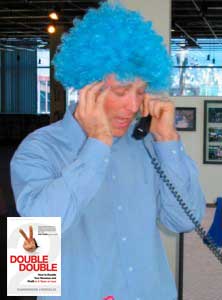
Which would you prefer, a PR team that proactively prepares and calls potential news sources to pitch stories, or one that hides behind a desk sending passive emails and writing releases for newswires?
Obviously, you’d want a proactive team member, but these are few and far between. Why? One word: fear.
One of the biggest obstacles to success in a PR is apathy that comes from anxiety.
The best PR takes a sales mentality, and a sales mentality means cold-calling and making pitches. Many PR professionals are more marketers than salespeople, and the idea of cold calling is terrifying. The good news is that the right preparation goes a long way towards overcoming fear—and towards creating a successful PR strategy.
And the one of the most important steps in preparing for a cold call is to have your script ready.
The PR sales script
When contacting the media, I’ve found that a simple script works best to build confidence. Here’s an example of mine.
“Hi, my name is Cameron. Do you have a couple of minutes? I think I have a great story for you.”
The writer will say one of the following:
(a) “Sure. What have you got?” To which I’ll say: “Well, I have this cool story about this [fill in the blank]. Here are a couple of quick bullet points.” Then, being the salesperson that I am, I ask, “What do you think?” I then continue to ask questions, and listen.
(b) “Sorry, I’m on a deadline.” To which I’ll say: “Okay. I’ll call you tomorrow, or would the day after be better?” I’ll also take the opportunity to ask what the reporter is working on and listen to what he or she says. From there, I’ll suggest helpful options for achieving the writer’s goals. By doing this, I achieve my own at the same time. Finally, if possible, I also suggest ways I could share expert comments for the reporter’s current story.
(c) “No.” To which I’ll respond when the person hang ups on me: “Okay, so I’ll just go grab a cup of coffee, sit down, and call the next person on my list.” I’m one call closer to a yes!
Talk less, listen more
As the saying goes in sales, you have two ears and one mouth—use them in that ratio! The conversation should go something like this: you ask questions, you listen, you listen, you ask questions, you listen, and you listen some more.
Too many people show up and throw up. Don’t give the writer who answers the phone your entire story. Instead, quickly give the person your first little angle, and then ask, “What do you think?” The writer will give you an opinion right away, and then you’ll narrow or amend your angle a little bit more or hit the writer with your second angle, or your third angle—which ever fits better. Stay alert and focused on the task at hand.
Following up
Sometimes you’ll strike out and not be able to get a hold of someone. The good news is that since you’re on the phone you can leave a voice mail. If I have to leave a voice mail, I usually leave a message like this: “Hi Susan, this is Cameron Herold. Sorry I missed you, but I think I have a great story angle for you. I’ll give you a call about it tomorrow. If you have a chance before then, you can call my cell: YYY-XXX-CCCC.”
After connecting with a writer, or after a writer covers you, a follow-up email are fine for thanking him or her. That being said, a handwritten thank-you note to him or her, mailed (as in placed in an envelope with a stamp), is 100 percent better. No one sends thank- you cards to just say thanks anymore, and you should—you’ll stand out. Landing Free Publicity is as easy as picking up the phone.


 Here is the third step in getting free PR:
Here is the third step in getting free PR: Here is the 2nd step on how you can get free PR:
Here is the 2nd step on how you can get free PR:




